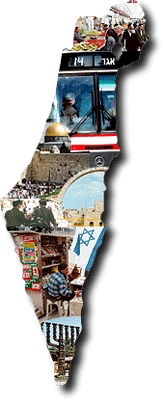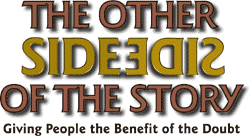Light Lines - Vayechi
Parshat Vayechi
18 Tevet 5761 / January 13, 2000
Ohr Somayach Home Page
MIRROR, MIRROR
Strange things happen to people when they look in a mirror. Their normal expression becomes contorted. An eyebrow is raised. Lips are pursed. The head is turned ever so slightly to the right and then to the left.
When we look in the mirror, we see ourselves not so much as we really are, but as we'd like to be: Head held a little higher, the posture more erect and holding in our breath so that clothes don't betray the evidence of one too many slices of chocolate cake.
When we look at other people, however, our perspective changes radically. Rather than emphasize the positive, we tend to scrutinize their defects and lay the stress on what's wrong with them. What we see in ourselves as prudent, in others becomes stingy. Where we are vivacious, others are loud.
In this week's parsha, when Jacob blessed Joseph's children Ephraim and Menashe, Jacob crossed his hands. He placed his right hand, his stronger hand, on the younger son Ephraim, and his weaker left hand on Menashe, the elder son. But wouldn't it have been easier for Jacob to have told Ephraim to stand opposite his right hand and Menashe opposite his left? That way there would have been no need for him to cross his hands.
The right side symbolizes strength and importance. The left symbolizes weakness and insignificance. When we look at ourselves in the mirror, our right hand is reflected on the right side of the mirror. In other words, our strengths are reflected as being important. Our left hand, the hand that characterizes weakness, corresponds to our left hand in the mirror. Meaning that we see our weaknesses as insignificant. However, when we stand opposite someone else, our right hand corresponds to their left hand, meaning we emphasize their shortcomings. Our left hand is opposite their right -- we play down their strengths.
This is what Jacob was teaching the two brothers Ephraim and Menashe. When you look at each other, use the eyes that you use for yourself. See the other person's weakness as secondary, and his virtues as being his essence.
|
Ohr Somayach Home Page |
 Selections from classical Torah sources which express the special relationship between the People of Israel and Eretz Yisrael BNEI BRAK Mentioned as one of the cities in the portion of the Tribe of Dan (Joshua 19:45), Bnei Brak is famous in the Talmud (Sanhedrin 32b) as the seat of Rabbi Akiva's court, and in the Passover Haggada as the site of the all-night Pesach Seder of Rabbi Akiva and his distinguished colleagues. The city had an agricultural dimension as well, as appears from the account (Kesuvos 111b) of the Sage Rami bar Yechezkel who declared that he understood the meaning of the Torah's description of the Land of Israel as a "land flowing with milk and honey" after witnessing a scene during a visit to Bnei Brak. He observed goats grazing beneath fig trees. The honey oozing from the very ripe figs merged with the milk dripping from the goats and formed a stream of milk and honey. The Bnei Brak of today was established in 1924 by Jews from Poland, and is famed for its many yeshivot and Chassidic communities. |
|
Ohr Somayach Home Page |
To put a bad scenario in a good light sometimes takes more than just imagination. Sometimes...
It Takes a Thief
Not long ago, in the midst of the various terrorist attacks in Israel, a Jewish person at the rush of a bustling Dizengoff intersection in Tel Aviv alerted those surrounding him that the bag he just brought there contained a live bomb!
After the squad disconnected the explosive, the person was investigated by the police. The man explained that earlier he was at the beach; and meaning to steal the contents of a good-looking bag, he picked it up, escaped the security and opened it at the Dizengoff intersection.
To his dismay, inside, instead of finding something of value -- he found a bomb!
Apparently that bag had been planted at the beach by terrorists earlier that day. Through his intention to steal, this "bag-picker" saved a hazard. If, G-d forbid, that bag had exploded a minute earlier in the midst of a bustling intersection, what would the world have thought about this man? Would anyone have let his imagination drift and thought: "That guy probably stole the bag, and it just so happened to contain a bomb?"
Many times, what seems to be imagination proves to be reality. So let's follow the directive of the Torah and judge favorably.
|
Ohr Somayach Home Page |
Accounting for the Prophets
Phil Bondman wrote:
Who were the seven female prophetesses?
Stanley Turtletaub wrote:
Someone asked me if Rachel and Leah were prophetesses like Sarah and Rebecca. I answered yes. For Leah, I responded that she foresaw that she was to marry Esaw and cried and pleaded with G-d until her lot was changed. But how do we see that Rachel was a prophetess?
Dear Phil and Stanley,
The Talmud states: "48 prophets and 7 prophetesses prophesied to the People of Israel." The prophetesses are identified as Sarah, Miriam, Debra, Chana, Abigail, Chulda and Esther.
The Talmud goes on to explain that, although there were actually thousands of other prophets, these were the ones whose prophecy was written down to teach repentance and give direction to future generations.
Both Rachel and Leah were prophetesses. For example, Leah foretold that Reuven would lose his birthright to Joseph, and that Reuven would try to save Joseph's life. Rachel knew prophetically that Jacob would only have twelve sons; thus when she bore Joseph, Jacob's 11th son, she prayed only for "another son" and not for "more sons."
Three Parts of Soul
Eliezer Shifrin wrote:
What is the difference between spirit, soul, and neshama, according to the kabbala, and how long does the spirit or soul linger after death? Thank you for your help.
Dear Eliezer,
A soul is like a chain with one end linked into the brain and the other to a certain spiritual source. There are five levels of the soul like the five links in a chain, each one parallel to the spiritual sphere where it exists. However, we only relate to the three bottom links as we have no understanding about the two top ones. The three are 1) Nefesh 2) Ruach 3) Neshama. The nefesh is the spiritual existence which resides in the body and keeps the physical metabolism working and the person alive. The ruach is a connection between the neshama and the nefesh. It is the cause of feelings and personal qualities. The neshama is the spiritual existence which pulls the man towards G-d, to the performance of good deeds, to be pious and humble and to seek knowledge and achievement in spiritual fields. It resides around the head.
When a person dies, it takes seven days before the parts of the soul understand that it's all over and leave the body. Until then they hover around the grave and travel to and fro between the grave and the house of the deceased, waiting for the body to start functioning again. The nefesh does not completely leave until the body is decomposed.
Light Insight | Love of the Land | The Other Side of the Story | Response Line Ohr Somayach Home Page |
Produced by the Office of Communications
Editor: Raphael Scott Leban
Production: Eliezer Shapiro
HTML Production: Michael Treblow
© 2001 Ohr Somayach International - All rights reserved. This publication may be distributed to another person intact without prior permission. We also encourage you to include this material in other publications, such as synagogue newsletters. However, we ask that you contact us beforehand for permission, and then send us a sample issue.
Ohr Somayach Institutions is an international network of Yeshivot and outreach centers, with branches in North America, Europe, South Africa and South America. The Central Campus in Jerusalem provides a full range of educational services for over 685 full-time students.









